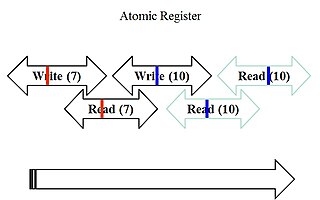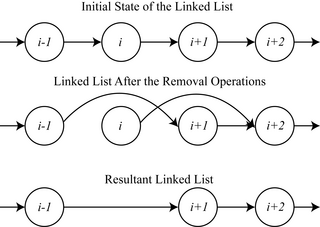
Atomic semantics is a type of guarantee provided by a data register shared by several processors in a parallel machine or in a network of computers working together. Atomic semantics are very strong. An atomic register provides strong guarantees even when there is concurrency and failures.

In computer science, garbage collection (GC) is a form of automatic memory management. The garbage collector attempts to reclaim memory which was allocated by the program, but is no longer referenced; such memory is called garbage. Garbage collection was invented by American computer scientist John McCarthy around 1959 to simplify manual memory management in Lisp.
In computer science, reference counting is a programming technique of storing the number of references, pointers, or handles to a resource, such as an object, a block of memory, disk space, and others.
Safe semantics is a computer hardware consistency model. It describes one type of guarantee that a data register provides when it is shared by several processors in a parallel computer or in a network of computers working together.

In computer science, mutual exclusion is a property of concurrency control, which is instituted for the purpose of preventing race conditions. It is the requirement that one thread of execution never enters a critical section while a concurrent thread of execution is already accessing said critical section, which refers to an interval of time during which a thread of execution accesses a shared resource or shared memory.

Parallel computing is a type of computation in which many calculations or processes are carried out simultaneously. Large problems can often be divided into smaller ones, which can then be solved at the same time. There are several different forms of parallel computing: bit-level, instruction-level, data, and task parallelism. Parallelism has long been employed in high-performance computing, but has gained broader interest due to the physical constraints preventing frequency scaling. As power consumption by computers has become a concern in recent years, parallel computing has become the dominant paradigm in computer architecture, mainly in the form of multi-core processors.
Multiversion concurrency control, is a concurrency control method commonly used by database management systems to provide concurrent access to the database and in programming languages to implement transactional memory.
In compiler optimization, register allocation is the process of assigning local automatic variables and expression results to a limited number of processor registers.
In computer science, an algorithm is called non-blocking if failure or suspension of any thread cannot cause failure or suspension of another thread; for some operations, these algorithms provide a useful alternative to traditional blocking implementations. A non-blocking algorithm is lock-free if there is guaranteed system-wide progress, and wait-free if there is also guaranteed per-thread progress. "Non-blocking" was used as a synonym for "lock-free" in the literature until the introduction of obstruction-freedom in 2003.
In computer science, compare-and-swap (CAS) is an atomic instruction used in multithreading to achieve synchronization. It compares the contents of a memory location with a given value and, only if they are the same, modifies the contents of that memory location to a new given value. This is done as a single atomic operation. The atomicity guarantees that the new value is calculated based on up-to-date information; if the value had been updated by another thread in the meantime, the write would fail. The result of the operation must indicate whether it performed the substitution; this can be done either with a simple boolean response, or by returning the value read from the memory location.
JTAG is an industry standard for verifying designs and testing printed circuit boards after manufacture.
In computer science, a parallel random-access machine is a shared-memory abstract machine. As its name indicates, the PRAM is intended as the parallel-computing analogy to the random-access machine (RAM). In the same way that the RAM is used by sequential-algorithm designers to model algorithmic performance, the PRAM is used by parallel-algorithm designers to model parallel algorithmic performance. Similar to the way in which the RAM model neglects practical issues, such as access time to cache memory versus main memory, the PRAM model neglects such issues as synchronization and communication, but provides any (problem-size-dependent) number of processors. Algorithm cost, for instance, is estimated using two parameters O(time) and O(time × processor_number).

In concurrent programming, an operation is linearizable if it consists of an ordered list of invocation and response events, that may be extended by adding response events such that:
- The extended list can be re-expressed as a sequential history.
- That sequential history is a subset of the original unextended list.
General-purpose computing on graphics processing units is the use of a graphics processing unit (GPU), which typically handles computation only for computer graphics, to perform computation in applications traditionally handled by the central processing unit (CPU). The use of multiple video cards in one computer, or large numbers of graphics chips, further parallelizes the already parallel nature of graphics processing.
Replication in computing involves sharing information so as to ensure consistency between redundant resources, such as software or hardware components, to improve reliability, fault-tolerance, or accessibility.
In computer science, load-linked/store-conditional (LL/SC), sometimes known as load-reserved/store-conditional (LR/SC), are a pair of instructions used in multithreading to achieve synchronization. Load-link returns the current value of a memory location, while a subsequent store-conditional to the same memory location will store a new value only if no updates have occurred to that location since the load-link. Together, this implements a lock-free, atomic, read-modify-write operation.
In computer science, synchronization is the task of coordinating multiple of processes to join up or handshake at a certain point, in order to reach an agreement or commit to a certain sequence of action.
In computer science, the prefix sum, cumulative sum, inclusive scan, or simply scan of a sequence of numbers x0, x1, x2, ... is a second sequence of numbers y0, y1, y2, ..., the sums of prefixes of the input sequence:
In computer science, integer sorting is the algorithmic problem of sorting a collection of data values by integer keys. Algorithms designed for integer sorting may also often be applied to sorting problems in which the keys are floating point numbers, rational numbers, or text strings. The ability to perform integer arithmetic on the keys allows integer sorting algorithms to be faster than comparison sorting algorithms in many cases, depending on the details of which operations are allowed in the model of computing and how large the integers to be sorted are.
In distributed computing, shared-memory systems and message-passing systems are two means of interprocess communication which have been heavily studied. In shared-memory systems, processes communicate by accessing shared data structures. A shared (read/write) register, sometimes just called a register, is a fundamental type of shared data structure which stores a value and has two operations: read, which returns the value stored in the register, and write, which updates the value stored. Other types of shared data structures include read–modify–write, test-and-set, compare-and-swap etc. The memory location which is concurrently accessed is sometimes called a register.

















